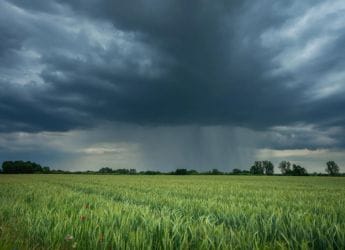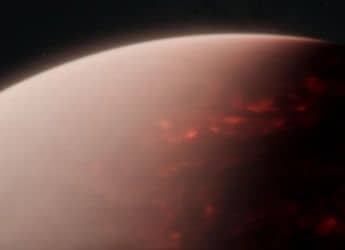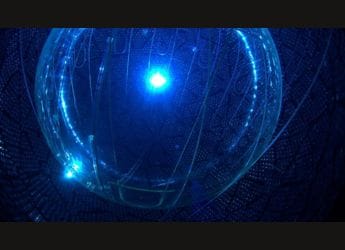- Home
- Science
- Science News
- NASA's Inflatable Greenhouse Could Feed Astronauts on Mars
NASA's Inflatable Greenhouse Could Feed Astronauts on Mars

Photo Credit: University of Arizona
NASA scientists have designed an inflatable greenhouse that astronauts could one day use to grow fresh food and produce oxygen on Mars or Moon.
The prototype involves an inflatable, deployable greenhouse to support plant and crop production for nutrition, air revitalisation, water recycling and waste recycling.
While astronauts have successfully grown plants and vegetables aboard the International Space Station (ISS), NASA wants to develop long-term methods that could help sustain pioneers working in deep space.
"The new approach uses plants to scrub carbon dioxide, while providing food and oxygen," said Ray Wheeler, lead scientist at the Kennedy Space Centre in Florida.
Wheeler noted that astronauts exhale carbon dioxide, which is then introduced into the greenhouse, and the plants then generate oxygen through photosynthesis.
The water cycle begins with water that is brought along or found at the lunar or Martian landing site.
Water is oxygenated, given nutrient salts, and it continuously flows across the root zone of the plants and returned to the storage system.
Tests involving the Prototype Lunar Greenhouse at the University of Arizona in the US have included determining what plants, seeds or other materials should be taken along to make the system work on the Moon or Mars.
Learning what to take and what to gather on site will be crucial for living on distant locations. Using available resources located or grown on site is a practice called in-situ resource utilisation, or ISRU, NASA said.
NASA scientists and engineers are developing systems to harness resources such as water that should be available in certain areas of the lunar or martian surface to support missions lasting for months or years.
"We are mimicking what the plants would have if they were on Earth and make use of these processes for life support," said Gene Giacomelli, professor at the University of Arizona.
"The entire system of the lunar greenhouse does represent, in a small way, the biological systems that are here on Earth," said Giacomelli.
Giacomelli said the next big step is to use additional lunar greenhouse units for specialised testing to ensure the system being developed will adequately support a crew of astronauts working on the Moon or Mars.
"We will develop computer models to simulate what we are doing to automatically control the environment and provide a constant level of oxygen," he said.
The prototypes now being developed are cylindrical - 18 feet long and more than 8 feet in diameter and were built by Sadler Machine Company, one of the project partners.
To protect from radiation in space, the greenhouse units would likely be buried under surface soil or regolith thus requiring specialised lighting, according to NASA.
"We have been successful in using electric LED (light emitting diode) lighting to grow plants. We also have tested hybrids using both natural and artificial lighting," Wheeler added.
Get your daily dose of tech news, reviews, and insights, in under 80 characters on Gadgets 360 Turbo. Connect with fellow tech lovers on our Forum. Follow us on X, Facebook, WhatsApp, Threads and Google News for instant updates. Catch all the action on our YouTube channel.
Related Stories
- Samsung Galaxy Unpacked 2025
- ChatGPT
- Redmi Note 14 Pro+
- iPhone 16
- Apple Vision Pro
- Oneplus 12
- OnePlus Nord CE 3 Lite 5G
- iPhone 13
- Xiaomi 14 Pro
- Oppo Find N3
- Tecno Spark Go (2023)
- Realme V30
- Best Phones Under 25000
- Samsung Galaxy S24 Series
- Cryptocurrency
- iQoo 12
- Samsung Galaxy S24 Ultra
- Giottus
- Samsung Galaxy Z Flip 5
- Apple 'Scary Fast'
- Housefull 5
- GoPro Hero 12 Black Review
- Invincible Season 2
- JioGlass
- HD Ready TV
- Laptop Under 50000
- Smartwatch Under 10000
- Latest Mobile Phones
- Compare Phones
- Redmi Note 15 5G
- Redmi Note 15 Pro 5G
- Redmi Note 15 Pro+ 5G
- Lava Play Max
- Poco C85 5G
- Honor Magic 8 Lite
- Jolla Phone
- Realme P4x 5G
- Asus ProArt P16
- MacBook Pro 14-inch (M5, 2025)
- OnePlus Pad Go 2
- Poco Pad M1
- Just Corseca Skywatch Pro
- Honor Watch X5
- Acerpure Nitro Z Series 100-inch QLED TV
- Samsung 43 Inch LED Ultra HD (4K) Smart TV (UA43UE81AFULXL)
- Asus ROG Ally
- Nintendo Switch Lite
- Haier 1.6 Ton 5 Star Inverter Split AC (HSU19G-MZAID5BN-INV)
- Haier 1.6 Ton 5 Star Inverter Split AC (HSU19G-MZAIM5BN-INV)

















